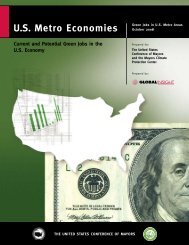APPENDIX C—Reserves <strong>and</strong> Resources193Reserves data are dynamic. They may be reduced asore is mined <strong>and</strong>/or the extraction feasibility diminishes,or more commonly, they may continue to increase asadditional deposits (known or recently discovered) aredeveloped, or currently exploited deposits are morethoroughly explored <strong>and</strong>/or new technology or economicvariables improve their economic feasibility. Reservesmay be considered a working inventory of miningcompanies’ supply of an economically extractablemineral commodity. As such, magnitude of thatinventory is necessarily limited by many considerations,including cost of drilling, taxes, price of the mineralcommodity being mined, <strong>and</strong> the dem<strong>and</strong> for it.Reserves will be developed to the point of businessneeds <strong>and</strong> geologic limitations of economic ore grade<strong>and</strong> tonnage. For example, in 1970, identified <strong>and</strong>undiscovered world copper resources were estimated tocontain 1.6 billion metric tons of copper, with reserves ofabout 280 million metric tons of copper. Since then,about 400 million metric tons of copper have beenproduced worldwide, but world copper reserves in 2010were estimated to be 630 million metric tons of copper,more than double those in 1970, despite the depletionby mining of more than the original reserves estimate.Future supplies of minerals will come from reserves <strong>and</strong>other identified resources, currently undiscoveredresources in deposits that will be discovered in thefuture, <strong>and</strong> material that will be recycled from current inuse-stocksof mineral or from minerals in waste disposalsites. Undiscovered deposits of minerals constitute animportant consideration in assessing future supplies.USGS reports provide estimates of undiscoveredmineral resources using a three-part assessmentmethodology (Singer <strong>and</strong> Menzie, 2010). <strong>Mineral</strong>resourceassessments have been carried out for smallparcels of l<strong>and</strong> being evaluated for l<strong>and</strong> reclassification,for the Nation, <strong>and</strong> for the world.Reference CitedSinger, D.A., <strong>and</strong> Menzie, W.D., 2010, Quantitative mineral resourceassessments—An integrated approach: Oxford, United Kingdom,Oxford University Press, 219 p.Part A—Resource/Reserve Classification for <strong>Mineral</strong>s 1INTRODUCTIONThrough the years, geologists, mining engineers, <strong>and</strong>others operating in the minerals field have used variousterms to describe <strong>and</strong> classify mineral resources, whichas defined herein include energy materials. Some ofthese terms have gained wide use <strong>and</strong> acceptance,although they are not always used with precisely thesame meaning.The USGS collects information about the quantity<strong>and</strong> quality of all mineral resources. In 1976, the USGS<strong>and</strong> the U.S. Bureau of Mines developed a commonclassification <strong>and</strong> nomenclature, which was published asUSGS Bulletin 1450–A—“Principles of the <strong>Mineral</strong>Resource Classification System of the U.S. Bureau ofMines <strong>and</strong> U.S. Geological Survey.” Experience with thisresource classification system showed that somechanges were necessary in order to make it moreworkable in practice <strong>and</strong> more useful in long-termplanning. Therefore, representatives of the USGS <strong>and</strong>the U.S. Bureau of Mines collaborated to revise Bulletin1450–A. Their work was published in 1980 as USGSCircular 831—“Principles of a Resource/ReserveClassification for <strong>Mineral</strong>s.”Long-term public <strong>and</strong> commercial planning must bebased on the probability of discovering new deposits, ondeveloping economic extraction processes for currentlyunworkable deposits, <strong>and</strong> on knowing which resourcesare immediately available. Thus, resources must becontinuously reassessed in the light of new geologicknowledge, of progress in science <strong>and</strong> technology, <strong>and</strong>of shifts in economic <strong>and</strong> political conditions. To bestserve these planning needs, known resources should beclassified from two st<strong>and</strong>points: (1) purely geologic orphysical/chemical characteristics—such as grade,quality, tonnage, thickness, <strong>and</strong> depth—of the materialin place; <strong>and</strong> (2) profitability analyses based on costs ofextracting <strong>and</strong> marketing the material in a giveneconomy at a given time. The former constitutesimportant objective scientific information of the resource<strong>and</strong> a relatively unchanging foundation upon which thelatter more valuable economic delineation can be based.The revised classification system, designed generallyfor all mineral materials, is shown graphically in figures 1<strong>and</strong> 2; its components <strong>and</strong> their usage are described inthe text. The classification of mineral <strong>and</strong> energyresources is necessarily arbitrary, because definitionalcriteria do not always coincide with natural boundaries.The system can be used to report the status of mineral<strong>and</strong> energy-fuel resources for the Nation or for specificareas. 1RESOURCE/RESERVE DEFINITIONSA dictionary definition of resource, “something inreserve or ready if needed,” has been adapted formineral <strong>and</strong> energy resources to comprise all materials,including those only surmised to exist, that have presentor anticipated future value.Resource.—A concentration of naturally occurring solid,liquid, or gaseous material in or on the Earth’s crustin such form <strong>and</strong> amount that economic extraction ofa commodity from the concentration is currently orpotentially feasible.Original Resource.—The amount of a resource beforeproduction.Identified Resources.—Resources whose location,grade, quality, <strong>and</strong> quantity are known or estimatedfrom specific geologic evidence. Identified resourcesinclude economic, marginally economic, <strong>and</strong> subeconomiccomponents. To reflect varying degrees ofgeologic certainty, these economic divisions can besubdivided into measured, indicated, <strong>and</strong> inferred.1 Based on U.S. Geological Survey Circular 831, 1980.
194Demonstrated.—A term for the sum of measuredplus indicated.Measured.—Quantity is computed fromdimensions revealed in outcrops, trenches,workings, or drill holes; grade <strong>and</strong>(or) qualityare computed from the results of detailedsampling. The sites for inspection, sampling,<strong>and</strong> measurements are spaced so closely <strong>and</strong>the geologic character is so well defined thatsize, shape, depth, <strong>and</strong> mineral content of theresource are well established.Indicated.—Quantity <strong>and</strong> grade <strong>and</strong>(or) qualityare computed from information similar to thatused for measured resources, but the sites forinspection, sampling, <strong>and</strong> measurement arefarther apart or are otherwise less adequatelyspaced. The degree of assurance, althoughlower than that for measured resources, is highenough to assume continuity between points ofobservation.Inferred.—Estimates are based on an assumedcontinuity beyond measured <strong>and</strong>(or) indicatedresources, for which there is geologic evidence.Inferred resources may or may not be supportedby samples or measurements.Reserve Base.—That part of an identified resource thatmeets specified minimum physical <strong>and</strong> chemicalcriteria related to current mining <strong>and</strong> productionpractices, including those for grade, quality,thickness, <strong>and</strong> depth. The reserve base is the inplacedemonstrated (measured plus indicated)resource from which reserves are estimated. It mayencompass those parts of the resources that have areasonable potential for becoming economicallyavailable within planning horizons beyond those thatassume proven technology <strong>and</strong> current economics.The reserve base includes those resources that arecurrently economic (reserves), marginally economic(marginal reserves), <strong>and</strong> some of those that arecurrently subeconomic (subeconomic resources). Theterm “geologic reserve” has been applied by othersgenerally to the reserve-base category, but it alsomay include the inferred-reserve-base category; it isnot a part of this classification system.Inferred Reserve Base.—The in-place part of anidentified resource from which inferred reserves areestimated. Quantitative estimates are based largelyon knowledge of the geologic character of a deposit<strong>and</strong> for which there may be no samples ormeasurements. The estimates are based on anassumed continuity beyond the reserve base, forwhich there is geologic evidence.Reserves.—That part of the reserve base which couldbe economically extracted or produced at the time ofdetermination. The term reserves need not signifythat extraction facilities are in place <strong>and</strong> operative.Reserves include only recoverable materials; thus,terms such as “extractable reserves” <strong>and</strong>“recoverable reserves” are redundant <strong>and</strong> are not apart of this classification system.Marginal Reserves.—That part of the reserve basewhich, at the time of determination, borders on beingeconomically producible. Its essential characteristic iseconomic uncertainty. Included are resources thatwould be producible, given postulated changes ineconomic or technological factors.Economic.—This term implies that profitable extractionor production under defined investment assumptionshas been established, analytically demonstrated, orassumed with reasonable certainty.Subeconomic Resources.—The part of identifiedresources that does not meet the economic criteria ofreserves <strong>and</strong> marginal reserves.Undiscovered Resources.—Resources, the existenceof which are only postulated, comprising deposits thatare separate from identified resources. Undiscoveredresources may be postulated in deposits of suchgrade <strong>and</strong> physical location as to render themeconomic, marginally economic, or subeconomic. Toreflect varying degrees of geologic certainty,undiscovered resources may be divided into twoparts:Hypothetical Resources.—Undiscovered resourcesthat are similar to known mineral bodies <strong>and</strong> thatmay be reasonably expected to exist in the sameproducing district or region under analogousgeologic conditions. If exploration confirms theirexistence <strong>and</strong> reveals enough information abouttheir quality, grade, <strong>and</strong> quantity, they will bereclassified as identified resources.Speculative Resources.—Undiscovered resourcesthat may occur either in known types of deposits infavorable geologic settings where mineraldiscoveries have not been made, or in types ofdeposits as yet unrecognized for their economicpotential. If exploration confirms their existence<strong>and</strong> reveals enough information about theirquantity, grade, <strong>and</strong> quality, they will bereclassified as identified resources.Restricted Resources/Reserves.—That part of anyresource/reserve category that is restricted fromextraction by laws or regulations. For example,restricted reserves meet all the requirements ofreserves except that they are restricted fromextraction by laws or regulations.Other Occurrences.—Materials that are too low gradeor for other reasons are not considered potentiallyeconomic, in the same sense as the definedresource, may be recognized <strong>and</strong> their magnitudeestimated, but they are not classified as resources. Aseparate category, labeled other occurrences, isincluded in figures 1 <strong>and</strong> 2. In figure 1, the boundarybetween subeconomic <strong>and</strong> other occurrences islimited by the concept of current or potential feasibilityof economic production, which is required by thedefinition of a resource. The boundary is obviouslyuncertain, but limits may be specified in terms ofgrade, quality, thickness, depth, percent extractable,or other economic-feasibility variables.Cumulative Production.—The amount of pastcumulative production is not, by definition, a part ofthe resource. Nevertheless, a knowledge of what hasbeen produced is important in order to underst<strong>and</strong>current resources, in terms of both the amount of pastproduction <strong>and</strong> the amount of residual or remainingin-place resource. A separate space for cumulativeproduction is shown in figures 1 <strong>and</strong> 2. Residualmaterial left in the ground during current or futureextraction should be recorded in the resourcecategory appropriate to its economic-recoverypotential.
- Page 3:
U.S. Department of the InteriorKEN
- Page 6 and 7:
INTRODUCTION3Each chapter of the 20
- Page 8 and 9:
5NET EXPORTS OF MINERALRAW MATERIAL
- Page 10 and 11:
SIGNIFICANT EVENTS, TRENDS, AND ISS
- Page 12 and 13:
mineral materials valued at $1.30 b
- Page 14 and 15:
11MAJOR METAL-PRODUCING AREASAuB2P1
- Page 16 and 17:
13MAJOR INDUSTRIAL MINERAL-PRODUCIN
- Page 18 and 19:
ABRASIVES (MANUFACTURED)15Events, T
- Page 20 and 21:
ALUMINUM17The United States continu
- Page 22 and 23:
ANTIMONY19Events, Trends, and Issue
- Page 24 and 25:
ARSENIC21According to university me
- Page 26 and 27:
ASBESTOS23Events, Trends, and Issue
- Page 28 and 29:
BARITE25Nationally, the rig count o
- Page 30 and 31:
BAUXITE AND ALUMINA27Events, Trends
- Page 32 and 33:
BERYLLIUM29Events, Trends, and Issu
- Page 34 and 35:
BISMUTH31Events, Trends, and Issues
- Page 36 and 37:
BORON33Events, Trends, and Issues:
- Page 38 and 39:
BROMINE35Events, Trends, and Issues
- Page 40 and 41:
CADMIUM37NiCd battery use in consum
- Page 42 and 43:
CEMENT39The manufacture of clinker
- Page 44 and 45:
CESIUM41Events, Trends, and Issues:
- Page 46 and 47:
CHROMIUM43Stockpile Status—9-30-1
- Page 48 and 49:
CLAYS45Tariff: Item Number Normal T
- Page 50 and 51:
COBALT47Events, Trends, and Issues:
- Page 52 and 53:
COPPER49Events, Trends, and Issues:
- Page 54 and 55:
DIAMOND (INDUSTRIAL)51Events, Trend
- Page 56 and 57:
DIATOMITE53Events, Trends, and Issu
- Page 58 and 59:
FELDSPAR55Feldspar use in tile and
- Page 60 and 61:
FLUORSPAR57with planned output of 1
- Page 62 and 63:
GALLIUM59In response to the unprece
- Page 64 and 65:
GARNET (INDUSTRIAL)61Events, Trends
- Page 66 and 67:
GEMSTONES63Events, Trends, and Issu
- Page 68 and 69:
GERMANIUM65Events, Trends, and Issu
- Page 70 and 71:
GOLD67With the increase in price of
- Page 72 and 73:
GRAPHITE (NATURAL)69Events, Trends,
- Page 74 and 75:
GYPSUM71Through 2010, more than 3,6
- Page 76 and 77:
HELIUM73Events, Trends, and Issues:
- Page 78 and 79:
INDIUM75China’s 21 indium produce
- Page 80 and 81:
IODINE77Events, Trends, and Issues:
- Page 82 and 83:
IRON AND STEEL79Events, Trends, and
- Page 84 and 85:
IRON AND STEEL SCRAP81Tariff: Item
- Page 86 and 87:
IRON AND STEEL SLAG83Events, Trends
- Page 88 and 89:
IRON ORE85In 2009, China imported a
- Page 90 and 91:
IRON OXIDE PIGMENTS87Events, Trends
- Page 92 and 93:
KYANITE AND RELATED MATERIALS89Even
- Page 94 and 95:
LEAD91caused by underground fires a
- Page 96 and 97:
LIME93The lime industry is facing p
- Page 98 and 99:
LITHIUM95market, and a facility at
- Page 100 and 101:
MAGNESIUM COMPOUNDS97In Australia,
- Page 102 and 103:
MAGNESIUM METAL99U.S. magnesium con
- Page 104 and 105:
MANGANESE101Government Stockpile:St
- Page 106 and 107:
MERCURY103Events, Trends, and Issue
- Page 108 and 109:
MICA (NATURAL)105Depletion Allowanc
- Page 110 and 111:
MOLYBDENUM107Events, Trends, and Is
- Page 112 and 113:
NICKEL109Nickel prices were adverse
- Page 114 and 115:
NIOBIUM (COLUMBIUM)111Events, Trend
- Page 116 and 117:
NITROGEN (FIXED)—AMMONIA113Accord
- Page 118 and 119:
PEAT115Events, Trends, and Issues:
- Page 120 and 121:
PERLITE117Events, Trends, and Issue
- Page 122 and 123:
PHOSPHATE ROCK119Events, Trends, an
- Page 124 and 125:
PLATINUM-GROUP METALS121Events, Tre
- Page 126 and 127:
POTASH123Events, Trends, and Issues
- Page 128 and 129:
PUMICE AND PUMICITE125Events, Trend
- Page 130 and 131:
QUARTZ CRYSTAL (INDUSTRIAL)127Event
- Page 132 and 133:
RARE EARTHS129Events, Trends, and I
- Page 134 and 135:
RHENIUM131Events, Trends, and Issue
- Page 136 and 137:
RUBIDIUM133Events, Trends, and Issu
- Page 138 and 139:
SALT135Many chefs have advocated us
- Page 140 and 141:
SAND AND GRAVEL (CONSTRUCTION)137Ev
- Page 142 and 143:
SAND AND GRAVEL (INDUSTRIAL)139The
- Page 144 and 145:
SCANDIUM141Scandium’s use in meta
- Page 146 and 147: SELENIUM143Events, Trends, and Issu
- Page 148 and 149: SILICON145Events, Trends, and Issue
- Page 150 and 151: SILVER147Silver was used as a repla
- Page 152 and 153: SODA ASH149A Wyoming soda ash produ
- Page 154 and 155: SODIUM SULFATE151Events, Trends, an
- Page 156 and 157: STONE (CRUSHED)153Events, Trends, a
- Page 158 and 159: STONE (DIMENSION)155Events, Trends,
- Page 160 and 161: STRONTIUM157Events, Trends, and Iss
- Page 162 and 163: SULFUR159World sulfur production in
- Page 164 and 165: TALC AND PYROPHYLLITE161Events, Tre
- Page 166 and 167: TANTALUM163Events, Trends, and Issu
- Page 168 and 169: TELLURIUM165Events, Trends, and Iss
- Page 170: THALLIUM167Beginning in 2009, there
- Page 173 and 174: 170TIN(Data in metric tons of tin c
- Page 175 and 176: 172TITANIUM AND TITANIUM DIOXIDE 1(
- Page 177 and 178: 174TITANIUM MINERAL CONCENTRATES 1(
- Page 179 and 180: 176TUNGSTEN(Data in metric tons of
- Page 181 and 182: 178VANADIUM(Data in metric tons of
- Page 183 and 184: 180VERMICULITE(Data in thousand met
- Page 185 and 186: 182WOLLASTONITE(Data in metric tons
- Page 187 and 188: 184YTTRIUM 1(Data in metric tons of
- Page 189 and 190: 186ZEOLITES (NATURAL)(Data in metri
- Page 191 and 192: 188ZINC(Data in thousand metric ton
- Page 193 and 194: 190ZIRCONIUM AND HAFNIUM(Data in me
- Page 195: 192APPENDIX AAbbreviations and Unit
- Page 199 and 200: 196Part B—Sources of Reserves Dat
- Page 201: 198Europe and Central Eurasia—con







